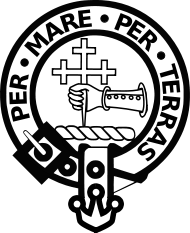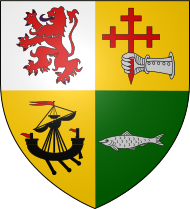| Clan Macdonald of Sleat Clann Ùisdein | |||
|---|---|---|---|
 | |||
| Motto | Per mare per terras (By sea and by land) | ||
| Profile | |||
| Region | Highland and Islands | ||
| District | Inverness-shire | ||
| Plant badge | Common heath[1] | ||
| Chief | |||
 | |||
| Sir Ian Godfrey Bosville Macdonald of Sleat[2] | |||
| 17th Baronet of Sleat, 25th Chief of Macdonald of Sleat[2] (Mac Ùisdein[3]) | |||
| Seat | Thorpe Hall, Rudston, East Yorkshire, England[4] | ||
| Historic seat | Dunscaith Castle;[5] Duntulm Castle;[6] Armadale Castle[7] | ||
| |||
| |||
Clan Macdonald of Sleat, sometimes known as Clan Donald North and in Gaelic Clann Ùisdein [kʰl̪ˠan̪ˠ ˈuːʃtʲɛɲ], is a Scottish clan and a branch of Clan Donald—one of the largest Scottish clans. The founder of the Macdonalds of Sleat was Ùisdean, or Hugh, a 6th great-grandson of Somerled, a 12th-century Lord of the Isles (Rì Innse Gall). The clan is known in Gaelic as Clann Ùisdein ("children of Ùisdean"), and its chief's Gaelic designation is Mac Ùisdein ("son of Ùisdean"), in reference to the clan's founder. Both the clan and its clan chief are recognised by the Lord Lyon King of Arms, who is the heraldic authority in Scotland.
The Macdonalds of Sleat participated in several feuds with neighbouring clans, most notably the Macleods of Harris & Dunvegan and the Macleans of Duart. The clan also suffered from infighting in the early 16th century, as the leading members of the clan fought and murdered each other.
The clan seems to have grudgingly supported the Royalist cause in the Wars of the Three Kingdoms, and suffered grievously in military defeats against Parliamentarian forces. The clan supported the Jacobite cause in the 1715 rebellion, yet refused to come out for Bonnie Prince Charlie and his father a generation later in 1745. In the early 18th century, the clan's chief was involved in a plan to sell tenants into indentured servitude in the American Colonies. By the late 18th century, the chiefs had alienated themselves from the common clansfolk, when they seated themselves in northern England and rarely visited the old clan lands. The 18th and 19th centuries witnessed the suffering of the common clansfolk, as many were cleared off their lands at the hands of their absentee landlords. Today members and descendants of the clan live all over the world.
- ^ Cite error: The named reference
A1-541543was invoked but never defined (see the help page). - ^ a b Cite error: The named reference
burkes-peerage.net-BOSVILLEMACDONALDwas invoked but never defined (see the help page). - ^ Cite error: The named reference
highcouncilofclandonald.org-Sleatwas invoked but never defined (see the help page). - ^ "Clan Chiefs". Standing Council of Scottish Chiefs. Archived from the original on 26 July 2011. Retrieved 8 June 2009.
- ^ Cite error: The named reference
Macd3-1-6was invoked but never defined (see the help page). - ^ Cite error: The named reference
canmore-Duntulmwas invoked but never defined (see the help page). - ^ Cite error: The named reference
Macd3was invoked but never defined (see the help page).